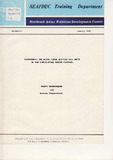Experiment on Model Crab Bottom Gill Nets in the Circulating Water Channel
Abstract
Crab bottom gill nets used in the Gulf of Thailand can be divided into two types; one is the monofilament bottom gill net and the other is the multifilament bottom gill net. It has long been questioned as to whether the monofilament net was more effective and profitable than the multifilament net in catching swimming crab.
In order to compare their catching efficiency, tests on actual monofilament and multifilament crab bottom gill nets were carried out in the Gulf of Thailand on board M.V. PLALUNG. The results of the experiments showed that the multifilament gill net seemed to have a higher catching efficiency than the monofilament gill net from the abundance of crab caught. The different hang-in of the gill nets did not affect the catching efficiency.
However, in practice, a gill nets can be set across or in Line with the tide. In either position its shape will be modified by the dynamic water pressure which in turn may effect its fishing capacity.
TO complete the study of gill nets and obtain more information on the behaviour of both type of net in the water flow, a model experiment in the circulating water tank was carried out.
The initial objective was to observe how the gill net works in tides. Analysis of the first set measurements revealed, however, that the resistance and headline height of nets were systematically related to the netting parameters.
Further measurements were performed on monofilament and multifilament nylon nets to determine the relationship between resistance and headline height on twine type, direction and water speed.
This paper presents the results of the model experiments on crab gill net and the methods used, e.g. experiment on fishing nets performed by all trainees so that those interested in the operation of the circulating water channel could acquire a practical understanding outside the lecture room.

